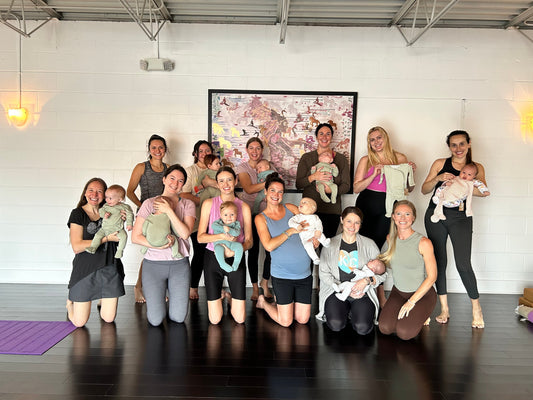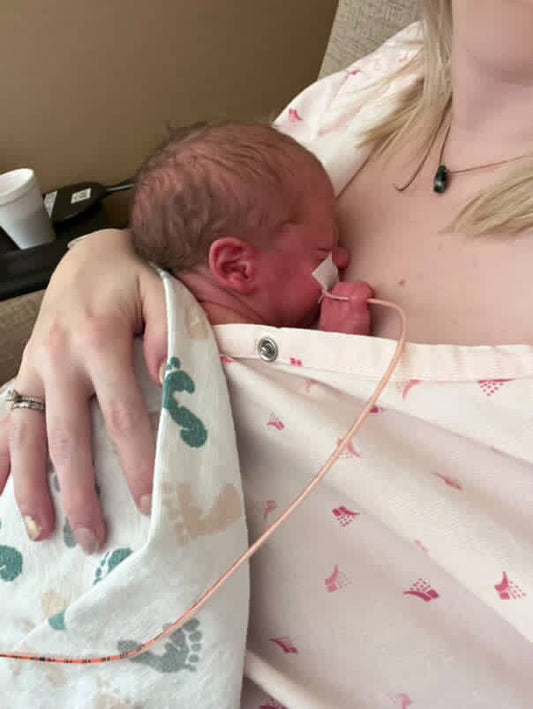Share
Integration of a Patient and Provider Perspective on Skin-to-Skin Contact
Navdeep SinghGuest Post by Jairrah L. Godsil
Bonsie’s previous article, Beyond the Statistics: “My son absolutely saved my life,” featured the memorable postpartum story of Jairrah Godsil, a pediatric occupational therapist and a certified breastfeeding specialist. A week after delivering her baby boy, she almost died from ruptured appendix, peritonitis, and a bowel obstruction. After two life saving surgeries and with the help of her newborn’s love, Jairrah lived to tell the tale. The support of her family, breastfeeding, skin-to-skin contact, and advice from a lactation consultant helped her reestablish her bond with her baby after weeks apart. She is now healthy, has a second baby boy, and continues to provide compassionate, expert care to her patients. Jairrah’s story and her medical perspective continues here:

Jairrah and Eric Jr, her little sunshine.
“I am thankful for the opportunity to share my story. I overcame the feelings of being a “statistic” and realized that I could voice my experiences to help others. Multiple confounding factors increased my risk for complications."
My Risks Were:
- I am African American/Black American and minority woman - an underserved population for medical care with known health disparities
- I was born prematurely - an increased risk for life-long health issues
- I was raised by teen parents - an increased risk for poverty and health-related issues
- I had an increased risk for pregnancy and/or postpartum complications. Black women have the highest postpartum/pregnancy morbidity and mortality rates
- I had an increased risk for breastfeeding issues. Black women have the lowest breastfeeding rate
- I had an increased risk for postpartum mental illness. Black women have the highest rate for mental health illnesses and are least likely to receive help.
The moral of my story is that I overlooked my OWN risks. I did not think the above circumstances would happen to me.
My support system enabled me to thrive and recover.
- My husband, parents, and in-laws ensured food and support daily
- My co-workers and friends extended a helping hand
- I had specialized medical care from amazing doctors and nurses
- My nurses advocated for me to see my son when I was critically ill
- My doctors supported my breastfeeding goals
- I received support from a lactation consultant
- I was knowledgeable of medical procedures and illnesses due to my line of work. I knew how and when to get help
- My friends and co-workers extended a helping hand
- My mom was my strongest advocate for breastfeeding. She believed in me, She also breastfed me as an infant
- My husband financially supported us so I could stay at home, raise our son, and recover

Jairrah and her second born son, Lincoln
After enduring a maternal health emergency and working again as a medical provider, I changed a few things to better support families during traumatic experiences.
- I am more delicate and compassionate when I interact with families
- I make breastfeeding goals a priority if families want to, and advocate for them
- I am aware of the extensive support families need following medical emergencies
- I advocate for minority and at-risk populations
- I am more intuitive to postpartum struggles
- I educate families on the benefits of skin-to-skin, and I speak of it every opportunity I can
- I help families overcome barriers to skin-to-skin and breastfeeding
- I embrace the importance of sensitive moments. First feedings and holding after separation are special moments that will be remembered forever.
My Experience with Skin-to-Skin as a Mom and Patient:
- Skin-to-skin contact helped me to reestablish my bond with my newborn after being away from him for 3 weeks
- It initiated and sustained our breastfeeding relationship
- It boosted my milk supply by the release and activation of the milk ejection reflex
- It provided comfort to us both during a difficult recovery
Skin-to-Skin Benefits: A Multi-Sensory Process:
Skin-to-skin is a multisensory experience that supports breastfeeding achievement. It enhances the release of oxytocin, improves bonding, normalizes vitals, and supports the milk ejection reflex. Skin-to-skin is the easiest and most natural thing to nurture mom and baby. It gently brings forth the best homeostasis in perfect synchrony for them. Skin-to-skin activates the primitive breast crawl. Newborns are innately born to use their hands/touch, sense of smell, and proprioception to locate the breast by chemosensory recognition and primitive reflex responses. Newborns can engage in the breast crawl within an hour after birth and breastfeed.
Skin-to-skin decreases stress responses and allows infants to safely experience their environment by affective touch, proprioception, hearing rhythmic bodily sounds (heart beat), maternal voice, and chemosensory recognition of breastmilk, resulting in the ultimate sensory experience for neurocognitive development. These experiences extend beyond birth and the newborn period; they have lifelong lasting effects. Other family members or caregivers can maximize the benefits too.
Skin-to-Skin Barriers Seen in Medical Provider Practice:
As an occupational therapist, feeding therapist, and certified breastfeeding specialist, I have seen the beauty and healing of skin-to-skin contact, emotionally, physically, and physiologically.
Skin-to-skin is simple, yet challenging at times depending on the medical status of mom or baby. One of the biggest challenges to engaging in skin-to-skin and breastfeeding is following a pediatric open chest or cardiac surgery. At times, parents are too scared to hold their child because of how fragile they are following surgery. Parents are often unable to engage in the traditional skin-to-skin position, limited by their child’s sternal precautions or restrictions for wound healing and incision safety. I help families safely complete skin-to-skin, bottle-feed, and breastfeed.
I discuss the benefits of skin-to-skin and breastfeeding for vital stability, bonding, and encourage positive experiences at the breast before oral feeding initiation. Infants with cardiac conditions often have difficulty with oral feeding following surgery. Therefore, I encourage mothers to practice skin-to-skin and let their baby come to the breast naturally without oral feeding expectations. The sensory experience of skin-to-skin alone brings comfort because of the smell of breastmilk, touch, and safe environmental exploration. Breastfeeding brings comfort and pain relief to infants as well. Breastfeeding acts as a coping strategy. Cardiac surgery can be a traumatic experience. Eventually, when infants are medically stable to orally feed, they can progress to feeding with professional help and guidance by a feeding therapist (occupational therapist or speech therapist) and lactation professional.

Jairrah practicing skin to skin after the birth of Eric Jr, her little sunshine.
When mothers engage in skin-to-skin at the hospital, their babies recover and breastfeed better.
Overcoming barriers to skin-to-skin contact and breastfeeding takes time and skilled help. I pursued and received a workplace scholarship for the Certified Breastfeeding Specialist (CBS) certification to enhance feeding opportunities for infants and families with complex medical needs.
“Touch plays a critical role in emotion and affective communication: we touch the people we care about and derive comfort from the touch of a loved one. Moreover, touch plays a key role in emotional communication: we touch the people we love, and the absence of normal affective touch in childhood has devastating consequences on emotional development. Touch and proprioception rely on a variety of different mechanoreceptors embedded in the skin, muscles, tendons, joints, and ligaments.” (Delhaye et al., 2019, p. 1-2).

Jairrah, Eric Jr, Eric Sr, and Lincoln
References:
Browne, J. V. (2008). Chemosensory development in the fetus and newborn. Newborn and Infant Nursing Reviews, 8(4), 180-186. https://doi.org/10.1053/j.nainr.2008.10.009
Centers for Disease Control and Prevention. (2022a). Pregnancy mortality surveillance system.
Centers for Disease Control and Prevention. (2022b). Breastfeeding Facts. Retrieved from https://www.cdc.gov/breastfeeding/data/facts.html
Centers for Disease Control and Prevention. (2021). Preterm birth. Retrieved from
Chantlani, S. (2022). Focusing on maternity and postpartum care for Black mothers leads to better outcomes. American Psychological Association, 53(7). https://www.apa.org/monitor/2022/10/better-care-black-mothers
Cong, X., Ludington-Hoe, S., M., Hussain, N., Cusson, R. M., Walsh, S., Vazquez, V., Briere, C.E., & Vittner, D. (2015). Parental oxytocin responses during skin-to-skin contact in pre-term infants. Early Human Development, 91, 7, 401-406. https://doi.org/10.1016/j.earlhumdev.2015.04.012.
Delhaye, B. P., Long, K. H., & Bensmaia, S. J. (2018). Neural basis of touch and proprioception in primate cortex. Comprehensive Physiology, 8(4), 575-1602. https://doi.org/10.1002/cphy.c170033
Jones, C.E., Desai, H., Gogel, J. L., Negrin, K. A., Torzone, A., Willette, S., Fridgen, J. L., Doody, L. R., Morris, K., Engstler, L., Slater, N. L., Medoff-Cooper, B., Smith, J., Harris, B., & Butler, S. C. (2021). Disruptions in the development of feeding for infants with congenital heart disease. Cardiology in the Young, 31,589-596. http://www.doi.org/10.1017/S1047951120004382
Mangan, S., & Mosher, S. (2012). Challenges to skin-to-skin kangaroo care: Cesarean delivery and critically ill nicu patients. Neonatal Network, 31(4), 259-261. https:/doi.org/10.1891/0730-0832.31.4.259
Mekonnen, A. G., Yehualashet, S. S., & Bayleyegn, A. D. (2019). The effects of kangaroo mother care on the time to breastfeeding initiation among preterm and lbw infants: A meta-analysis of published studies. International Breastfeeding Journal, 14(1), 1-6. https://doi.org/10.1186/s13006-019-0206-0
United Nations International Children’s Emergency Fund. (n.d.). Skin-to-skin contact. UNICEF. Retrieved from https://www.unicef.org.uk/babyfriendly/baby-friendly-resources/implementing-standards-resources/skin-to-skin-contact/
Vittner, D., McGrath, J., Robinson, J., Lawhon, G., Cusson, R., Eisenfeld, L., Walsh, S., Young, E., & Cong, X. (2018). Increase in oxytocin from skin-to-skin contact enhances development of parent-infant relationship. Biological Research For Nursing, 20 (1), 54-62. https://doi.org/10.1177/1099800417735633
Share
-
Category:
- All posts



